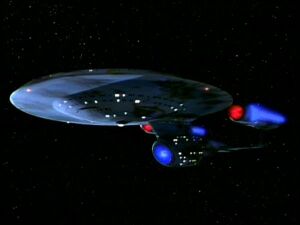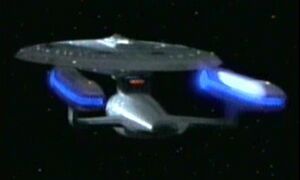Ambassador Class: Difference between revisions
Nicesociety (talk | contribs) |
Nicesociety (talk | contribs) |
||
| Line 32: | Line 32: | ||
===Main Bridge=== | ===Main Bridge=== | ||
[[Image:Ambassador class bridge.jpg|thumb|The command bridge of an ''Ambassador'' class starship]] | [[Image:Ambassador class bridge.jpg|thumb|The command bridge of an ''Ambassador'' class starship]] | ||
Primary operational control of the ''Ambassador'' class starship was provided by the | Primary operational control of the ''Ambassador'' class starship was provided by the Main Bridge. Located on top of the primary hull, the bridge directly supervised all primary mission operations and coordinated all departmental activities. | ||
In | In 2344, the central area of the bridge provided seating for the captain only. Directly fore and to the right of the captain was the ops station, with the helm station to the left. The consoles were similar to that used on the bridges of ''Excelsior'' and ''Galaxy'' class starships. At the very front of the bridge was a large viewscreen, with a freestanding console located directly below. Against the back walls of the bridge were consoles for the tactical station, engineering station, and science station positions. Additional displays flanked the aft consoles. The bridge was accessed through two doors, located on the forward halves of the port and starboard walls. | ||
==Ships commissioned== | ==Ships commissioned== | ||
Revision as of 18:47, 29 October 2007
History
Affiliation:United Federation of Planets/Starfleet Type:Heavy Cruiser Length: 526 meters Armament: Ten phaser arrays; two photon torpedo launchers Defenses:Deflector shields
The Ambassador class starship was a Starfleet heavy cruiser class launched in the mid 24th century.
The origins of the Ambassador class date back to the first half of the 24th century.
One of the most notable Ambassador class ships was the USS Enterprise (NCC-1701-C). In 2344, while under the command of Captain Rachel Garrett, the ship responded to a distress call from a Klingon colony on Narendra III. Four Romulan warbirds had ambushed the colony. The Enterprise responded to the attack, and despite being destroyed there, defended it long enough to impress the Klingon High Council.Hostilities ended almost immediately between the Klingon Empire and the United federation of Planets. A lasting peace agreement would not be reached until 2352, but the cessation of nearly 60 years of conflict between the two powers was a welcome step toward galactic peace.
Ships of the Ambassador class were utilized during the Klingon Civil War, and fought against the Borg and the Cardassians.
Technical Data
The Ambassador class featured the saucer section-engineering section-warp nacelle layout common to most Starfleet vessels. It was intermediate in size between the Excelsior and the Galaxy. The ship boasted at least three engineering levels. It was armed with both phasers and photon torpedoes with coverage to both fore and aft firing arcs. The control panels were flat-panel and LCARS based, using the interface introduced in the late 23rd century.
Families were allowed aboard Ambassador class ships, but only if they were related to a Starfleet crewmember who had served on the ship exceeding six months.
Refits
Several Ambassador class ships were seen with minor alterations from the original design. The saucer section's connection to the engineering hull was shifted slightly aft, with the nacelle pylon assembly moved a corresponding distance in the same direction. Cowlings were added around the Bussard collectors, making them appear closer to that of the Galaxy class, while the impulse engine exhaust changed from a blue to a red glow. The lower sensor dome became more elaborate and closer in appearance to the Excelsior class and the deflector dish was modified. Finally, the width of the shuttlebay was increased and a second facility resembling that on the Excelsior class engineering hull was mounted directly underneath the original one. Graphics were upgraded with the Starfleet insignia of the 2360s.The LCARS software was also upgraded to the standard interface of the late 24th century.
Interior
Main Bridge
Primary operational control of the Ambassador class starship was provided by the Main Bridge. Located on top of the primary hull, the bridge directly supervised all primary mission operations and coordinated all departmental activities.
In 2344, the central area of the bridge provided seating for the captain only. Directly fore and to the right of the captain was the ops station, with the helm station to the left. The consoles were similar to that used on the bridges of Excelsior and Galaxy class starships. At the very front of the bridge was a large viewscreen, with a freestanding console located directly below. Against the back walls of the bridge were consoles for the tactical station, engineering station, and science station positions. Additional displays flanked the aft consoles. The bridge was accessed through two doors, located on the forward halves of the port and starboard walls.
Ships commissioned
- Named
- Template:USS (NCC-1701-C)
- Template:USS (NCC-26517)
- Template:USS
- Template:USS (NCC-26510)
- Template:USS (NCC-26136)
- Uncertain
- Template:USS
- Template:USS (NCC-26531)
- Template:USS
- Template:USS
Appendices
Appearances
Background
Model
Very little is known about the Ambassador class starship. The term Ambassador class was first used in Template:TNG in reference to the Starship Horatio. It was connected to the Enterprise-C design on display graphics in "Yesterday's Enterprise."
The studio model was designed by Rick Sternbach, based on sketches produced by Andrew Probert for the first season of Star Trek: The Next Generation. The design was intended to suggest an intermediate step between the Excelsior class and the Galaxy class starships. A relief sculpture of Probert's design was placed in the observation lounge aboard the Template:USS. Unfortunately, the model was needed for "Yesterday's Enterprise" much sooner than the time it would take to fabricate the smoother lines of Probert's concept, requiring Sternbach's alterations which ended up on Greg Jein's final model.
The next appearance of the Ambassador class was as the Zhukov in "Data's Day." As noted above, the model was noticeably changed after it was rehabbed to remove the battle damage it sported as the Enterprise-C. This It would later appear in "Redemption II" as the Excalibur, appearing both as a redressed model and recycled footage, and would make its final appearance in "Emissary" as the Yamaguchi.
The model was eventually sent to Industrial Light & Magic for possible use in the final scene of Template:Film, but it was not included. There were unconfirmed reports that the model was destroyed in a warehouse fire shortly following Generations. Template:Incite
In actuality, the model of the ship was not destroyed, and was sold on October 7, 2006 as Lot #694 in the 40 Years of Star Trek: The Collection auction for $48,000 including the buyer's premium (the winning bid was $40,000). The model contained markings of both the Excalibur and Yamaguchi. [1]
Aside from the frequent appearances of the Ambassador-class relief sculptures throughout TNG, and later Template:Film and Template:Film, there were at least two other depictions of the Ambassador-class appearing on various LCARS displays, including a display shown in Template:TNG, and a classroom "Starship Chronology" display appearing during DS9 Season 2. No known computer generated model of the Ambassador was ever created.
Interior Design
The bridge of the Enterprise-C, the only internal space seen in detail aboard an Ambassador class starship, was a modification of the battle bridge, which in turn was built on the remains of the bridge set from Template:Film. William Riker and Geordi La Forge were seen on the Excalibur in "Redemption," but the scene was filmed against a generic console seen in the Enterprise-D science lab, among other locations.
Supplementals
According to the Star Trek Encyclopedia and the Star Trek: The Next Generation Technical Manual, the prototype of this class was the USS Ambassador, registry number NX-10521.
According to a line established in the script, but not the final airing, of "Yesterday's Enterprise", the crew complement of the Enterprise-C was 700.
The length of this vessel was established by Probert, and utilized in the Star Trek Encyclopedia and the Star Trek: The Next Generation Technical Manual. The Star Trek: The Next Generation Technical Manual further states that during the design phase the mass of this class of ship was expected to be at least 3.71 million tons. (pg. 75)
While these supplemental sources may not wholly be recognized as canon, they were conceived for use by the production staff of TNG, and have been interpreted by Memory Alpha as coming from a permitted resource.
Apocrypha
- The DS9 novel "Antimatter", mentions the Ambassador class USS Hannibal under construction at the newly reopened Okana shipyards, on Bajor's surface.
- The Ambassador class Excalibur was the star of the Peter David Star Trek: New Frontier novel series.
- The Decipher role-playing games supplement Starships includes the USS Krotus (NCC-26544).
- The USS Gandhi, listed here as an Ambassador class ship, is stated as being a Galaxy class ship in John Vornholt's book Double Helix: Quarantine.
- The Ambassador class ships Excalibur and Zhukov make appearances in the Star Trek: Bridge Commander PC game.
- The Ambassador class is often referred to as an "Alaska" class.
External links
- Template:Exastris: a full analysis of the modifications made between the Enterprise-C and Yamaguchi models
cs:Třída Ambassador de:Ambassador-Klasse es:Clase Ambassador fr:Classe Ambassador


